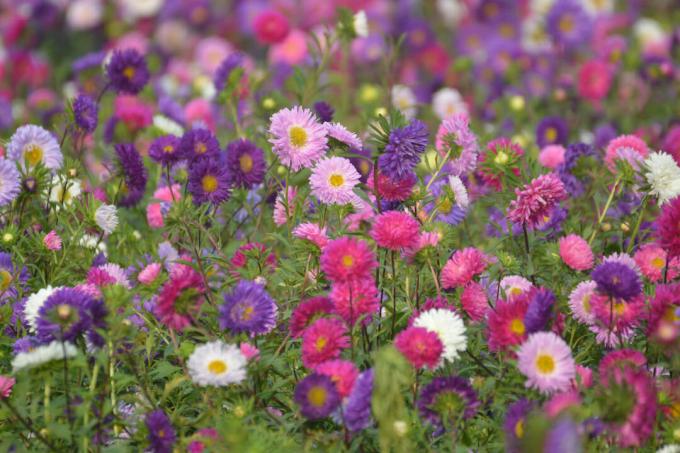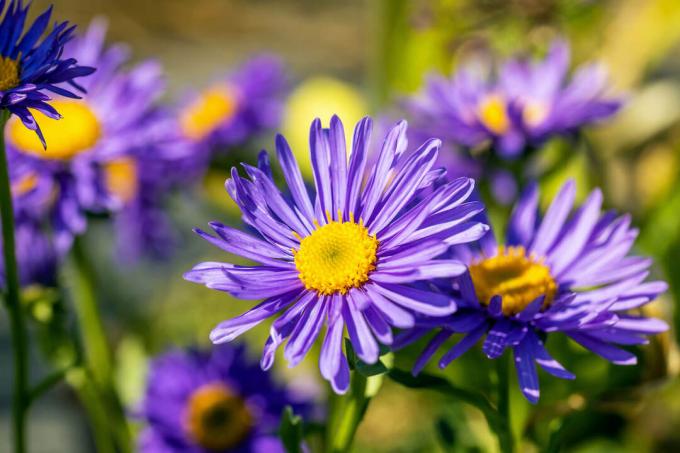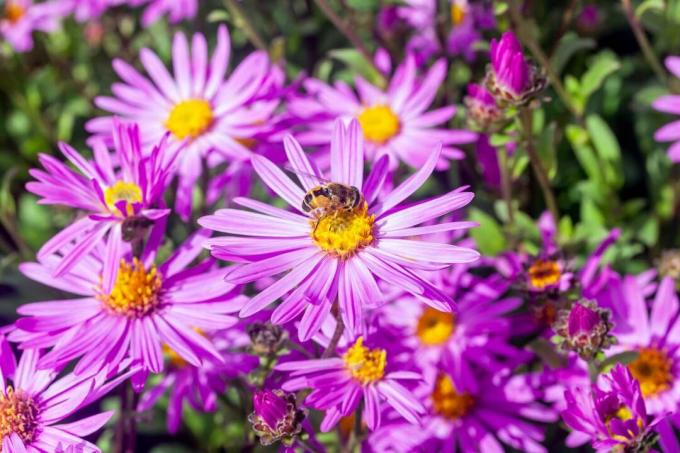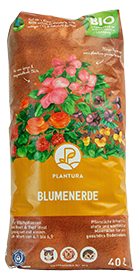There are well over 100 different species with several varieties and even different genera of the aster, which are very similar, for example in terms of the appearance of the flowers. With so much variety, it's easy to lose track.

the asters (asterspec., Symphyotrichum spec.; Callistephus spec.; Erigeron sp.) offer a wide range of options for designing your garden - with different colored flowers through to different growth forms and flowering times. We introduce you to the most beautiful genera, species and varieties of aster in this article.
Tip: Some asters were formerly of the genus aster belonging, but were later transferred to other genera. This results in a large group of plants of different genera, which we call "asters".
contents
- Aster species: how many are there?
-
The most beautiful aster species and varieties at a glance
- Alpine Aster (Aster alpinus)
- Early Summer Aster (Aster tongolensis)
- Mountain Aster (Aster amellus)
- Pyrenean Aster (Aster pyrenaeus)
- Umbrella Aster (Doellingeria umbellata; Syn. aster umbellatus)
- Summer aster (Callistephus chinensis)
- Goldhair Aster (Galatella linosyris; Syn. Aster linosyris)
- Schreber's Aster (Eurybia schreberi; Syn. aster scheberi)
Aster species: how many are there?
It is hardly possible to give clear information about the species number of asters. This is mainly due to the complicated botanical system in which the plants are assigned to families and genera and named accordingly. It happens again and again that changes are made in it due to new findings and plants that originally belong to the genus aster were then assigned to a different genus. The genus used to exist aster from about 500 to 600 species before a major rearrangement took place. These variants were widespread in Eurasia, in Africa and mainly in the New World. The species belonging to the genus according to the current systematics aster are only represented in the Old World – that is, in Europe, Asia and Africa.
The well-known smooth-leaf asters (Symphyotrichum novibelgii) and borage asters (Symphyotrichum novae-angliae) have been assigned to a new genus as they belong to the North American species. Other genera, which are also called asters and are characterized by a similar appearance, include the annual summer aster (Callistephus chinensis), the fine beam asters (Erigeron sp.), the beautiful asters (Kalimeris spec.) and the golden aster (Chrysopsis speciosa).
The new, correct botanical name often only slowly catches on in practice, which is why the old botanical name is also used as a synonym.

The most beautiful aster species and varieties at a glance
Many popular and well-known species such as the cushion aster (symphytricum x dumosum), the rough-leaf aster or smooth-leaf aster belong to the autumn asters, whose flowering period usually extends into autumn. These and other types are presented in our special article.
Spring Asters are rather low perennials, which usually carry their flower heads on unbranched stems. They like sunny locations and are suitable for rock gardens or other nutrient-poor places. In principle, all aster species are sufficiently hardy except for the one-year-old summer aster. Below we present the most beautiful types and varieties:
alpine aster (Aster alpinus)
The alpine asters reach a height of about 15 to 25 cm and prefer dry, warm and calcareous soil. This species blooms from May to June and is bee friendly. The varieties of this species are best planted individually or in small groups of about 1 to 3 plants 20 cm apart. We only present asters that have been rated by experts as particularly beautiful and naturally healthy.
- Aster alpinus ˈDark Beautyˈ: This floriferous variety with intense violet flowers has a great decorative effect and is very hardy.

- Aster alpinus ˈAlbusˈ: This variety is very resilient and also floriferous. The variety impresses visually with its pure white flowers.
- Aster alpinus ˈSabineˈ: ˈSabineˈ is a variety with high vitality, beautiful flowers and very low susceptibility to diseases. The anemone-flowered variety bears numerous purple flowers and reaches a height of 30 cm.
- Aster alpinus happy end: The floriferous variety ˈHappy Endˈ grows up to 35 cm high and also convinces with a high resistance to diseases. The good flower decoration effect is created by the pink flowers.

Early Summer Aster (Aster tongolensis)
The foliage of Early Summer Aster, also called early summer aster or Szechuan aster, forms a small carpet on the ground and the plant slowly spreads with short runners in the ground. The perennial can reach a height of about 40 cm and a width of about 25 to 30 cm. The flowering period of this species is from May to June. It feels good on fresh to moist, alkaline-rich and well-drained soil. Since the species can only withstand temperatures down to around -23 °C, it should only be planted in regions with correspondingly mild winters. The perennial can be planted individually or in smaller groups of about 3 to 10 specimens 25 cm apart.
- Aster tongolensis ˈWartburg Starˈ: This variety is characterized by its fragrant, large, blue-violet flowers that have an orange-yellow center.
- Aster tongolensis ˈLight Castleˈ: The intensely violet flowers of the "Light Castle" variety attract many bees, butterflies and other insects with their scent.

summer asters They usually bloom from July or August and are suitable for different locations. Depending on the variant, they can reach a height of 80 cm. The best-known and most beautiful types are presented below:
mountain aster (Aster amellus)
The mountain aster, also known as the lime aster, grows in a bushy form and loves sunny locations. In the right place, this species is uncomplicated and easy to care for. The bushy clumpy perennial thrives best on well-drained, low-nitrogen and dry to fresh, calcareous soil. The flowering period usually extends from mid or late July to late September. The species can be planted either singly or in smaller groups of up to about 10 plants at a distance of 40 cm.
- Aster amellus ˈQueen of Violetsˈ: This excellent variety has extremely plentiful flowers and has an excellent decorative effect due to the dark violet flowers. It flowers from early September to mid-October and is 50 to 60 cm high. In addition, it convinces with excellent stability, vitality and resistance to diseases.
- Aster amellus ˈBrilliantˈ: The healthy and stable variety ˈBrilliantˈ flowers purple-pink from the end of August to the end of September. It not only bears many flowers, but is also rarely attacked by diseases.

- Aster amellus ˈMiraˈ: The conspicuously rich-flowered variety 'Mira' was rated as very good and also reaches a height of 50 to 60 cm. Its blue-violet flowers create a beautiful ornamental effect from the end of August to the beginning of October. Stability and disease resistance are excellent.
Pyrenean Aster (Aster pyrenaeus)
The Pyrenean aster should be cultivated on poor, well drained, calcareous and dry to fresh soil in a sunny and warm location. The claims are similar to those of the mountain aster, however Aster pyrenaeus more enduring and robust. The flowering period of the bushy clumpy perennial is between mid-August and mid-October. It can be planted individually or in smaller groups of up to 10 plants 50 cm apart.
- Aster pyrenaeusˈLutetiaˈ: This extremely vigorous flowering variety convinces with good vigour. It grows to around 60 to 70 cm tall and its beautiful flowers are a light silvery pink in colour. It was rated as very good by the Perennial Inspection Working Group and has moderate to high resilience.

Umbrella Aster (Doellingeria umbellata; Syn. Aster umbellatus)
After successfully establishing itself in a suitable location, the small-flowered umbrella aster hardly needs any care. It prefers permeable, permanently fresh to moist soil and is very adaptable as far as the pH value of the subsoil is concerned. A sunny to semi-shady location is well suited for the species. It also copes well with root pressure from trees and shrubs and can therefore also be used at the edge of trees, under trees and shrubs. The perennial forms a broad, clump-like to slightly area-covering growth with short runners.
- Doellingeria umbellataˈWhite Screenˈ: The ˈWeißer Schirmˈ variety is very floriferous and bears its white flowers with a yellow center from the beginning of July to mid-September. Despite its height of 140 to 160 cm, it has excellent stability and high vitality. The resistance of the variety is very high and a special feature are the red stems in autumn.

summer aster (Callistephus chinensis)
In contrast to the other aster species, the summer aster is an annual, herbaceous plant that is not hardy. It is therefore well suited for cultivation as a cut flower. The summer asters usually bloom from July to October and prefer nutrient-rich, loose and moist soil in a sunny, airy location.
The variety of varieties of this species is so extensive that they are divided into several groups that differ in growth height and flower shape. Shorter varieties grow to around 20 to 30 cm in height, medium-tall between 40 and 50 cm and tall varieties can reach a size of 50 to 80 cm. The tall varieties are ideal as cut flower culture and the low ones can be cultivated wonderfully in pots or balcony boxes. A high-quality potting soil should be used as a substrate for this, which is mixed with sand or expanded clay to ensure good permeability. For example, ours is suitable for this Plantura organic potting soil excellent, which ideally supports your plants in growth with a balanced nutrient ratio and stimulates lush flowering.

Plantura organic potting soil
Organic, peat-free & climate-friendly:
For all flowering plants in pots & in beds,
ensures a lush, long-lasting bloom, 100% natural
Goldhair Aster (Galatella linosyris; Syn. Aster linosyris)
The gold hair aster is also called gold aster or gold crested aster. The umbel-like, golden-yellow flowers are its special feature. Unlike other aster species, these consist only of tubular flowers. Its flowering time is from the end of August to the beginning of October and it can reach a height of 50 to 60 cm. The bee-friendly perennial is very floriferous and beautiful to look at. It is stable and drives a lot of healthy foliage.
Tip: As a golden aster, the species is also Chrysopsis speciosa marked, so there is a risk of confusion here.

Schreber's aster (Eurybia scheberi; Syn. Aster scheberi)
In the trade, the Schrebers aster is usually called the heart leaf aster (Eurybia macrophylla ˈAlbusˈ; Syn. Aster macrophyllus ˈAlbusˈ), which may seem a bit confusing. But since the two are very similar, there is no disadvantage.
The small-flowered species thrives in light, partially shaded to shady locations with moderately nutritious to nutritious soil that is fresh to moist. The perennial also copes well with root pressure - which means that it can be optimally integrated under trees and shrubs. With runners, the Schreber's aster forms ground-covering areas with a height of 50 to 90 cm. The large, heart-shaped leaves make the plant quite dense. Their strong urge to spread should be considered when combined with other plants - they could crowd out other perennials.
From the beginning of July to mid-August, the extremely floriferous species bears clouds of white flowers and thus achieves a good decorative effect on the flowers. Despite the large growth height, the Schrebers-Aster proves its stability.
A biennial medicinal and aromatic plant that would do well in the same location as the Schreber's aster is the garlic mustard (Alliaria petiolata). You can find out how the plant can be used and what effects it can produce in our special article.
...and receive concentrated plant knowledge and inspiration directly in your e-mail inbox every Sunday!
